The South Downs Way 50
Posted by Ed on April 27, 2021
Summary
The 2021 South Downs Way 50 miler took place on the 17th of April. Running for 49 miles from Worthing to Eastbourne along the iconic South Downs Way, the race took in approximately 5500 feet or 1700 metres of cumulative elevation gain, and was the first in the 2021 Centurion 50 mile Grand Slam series. I finished in 9:12:24, 84th overall, 80th male, and 34th in my age category.
Race report
One thing I’ve come to recognise in the five-and-a-bit years I’ve been running is that you can expect great things the second time you run a distance. I ran my first half marathon, for instance, in 2:03 and change, whilst I flew through my second, just two months later, in 1:32. My first 50k at Tarawera took me over seven and a half hours to complete – nine months later, I ran 4:38 on a similar Rotorua course.
These drastic improvements are in large part attributable to having broken the psychological barrier that prevents one pushing too hard the first time one runs a distance. When you’ve wrapped your head around what 21.1km feels like, it’s a lot easier to judge what a ‘sustainably difficult’ pace is. (I’m yet to actually run my second proper road marathon, but, having run 3:33 in my first, I am hopeful to next year run a time close to, if not below, three hours, with the help of a good training block.)
It was with these ideas floating around my head that, after 13 months of lockdowns, delays, and restrictions, I finally toed the line at my first Centurion event, the South Downs Way 50, on Saturday 17th April in Worthing. It was, to quote George Orwell, a bright, cold day in April. With literally not a cloud in the sky, and with temperatures predicted to max out around an ideal twelve degrees, conditions were PB perfection. Having run 9:51 last July in a solo 50 mile run following the postponement of the SDW50’s sister event, the North Downs Way 50, I had a decent psychological grasp of what the distance demanded. But there were a couple of factors I had to keep in mind that could feasibly have prevented or otherwise rendered inadvisable any PB hunting.
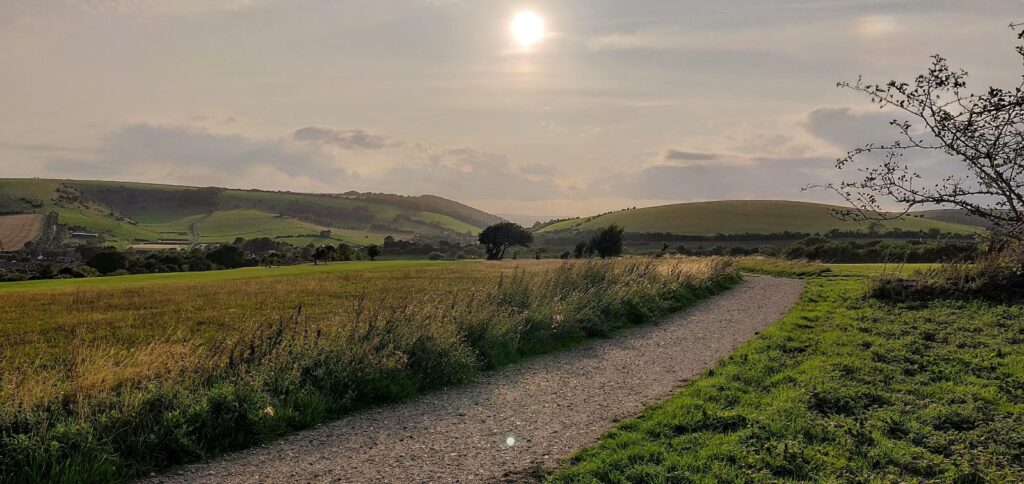
The first was simply the course. Back in July, my self-designed 50 mile route was decently hilly, following the Ridgeway for its first third and the Chiltern Way for much of the rest of the course. But, meandering out of the Chiltern Hills and into the much more modest terrain surrounding Watford and Bushey, the climbs definitely petered out as the route neared completion. By the halfway point, I had climbed about 800 of the 1300+m that the route took in, making the negative split I ran quite manageable, even on tired legs.
The South Downs Way, by contrast, is consistently – though not terrifyingly – hilly from end to end. With a good 400m more climbing than my run last summer, I knew to expect a tougher day out, not least in the final third, which could quash any hopes of a PB.
Secondly, the South Downs Way 50 is just the first in the Centurion ‘Grand Slam’ of 50 milers, for which I have signed up in 2021. The second event in the series – the gnarlier, longer North Downs Way 50 (which is actually around 53 miles) – comes just five weeks after the first, meaning any injuries, blow-ups, or over-exertion accumulated in the South Downs Way 50 risked jeopardising a year’s worth of achievement.
With that in mind, I wanted to use the SDW 50 as a chance to put some theories into practice and see if I could eke out a PB without relying on the age-old technique of actually running faster. Going into the race, I had a few principles in mind as to how I might shave off some vital minutes from my previous time. These were:
- Less time standing still. In July, my total moving time was a good 30+ minutes shorter than my total elapsed time, meaning I had lost half an hour to standing still. Of course, not all of that time was wasted – aid stations are a crucial part of long efforts, and whilst my run in July was a solo effort, I did have support in the form of running pal and seasoned Centurion veteran Spencer, who showed up every 10k from the halfway point with water, coke, food, and encouragement. But it’s definitely the case that, bewildered as I was by the scale of the challenge, I spent more time than I should have dilly-dallying and chatting to Spencer, and thus I lost time overall. My aid station plan going into the SDW 50 was simple: in and out. No hanging about.
- Recover on the flats. The SDW 50 is a hilly race, but not relentlessly so. Having hiked on the South Downs a number of times, I knew to expect a series of long, gradual climbs, followed by mile upon mile of flat ‘ridge’ running, before dropping back down into each aid station. Regardless of how each climb went (and I intended to run at least some of them in part), I wanted to avoid ‘walking off’ each ascent, and instead aim to recover from each climb by jogging it out. So much of a successful ultramarathon strategy involves building and maintaining momentum, and I knew that sticking (for as long as possible) to the principle of “if it’s runnable, run it (gently)” was a surefire way to claw back some time.
- Actually run the descents. Racing any distance is always a balancing act. Go too slow, and you’re out there for longer and risk underperforming. Go too fast, and you’ll blow up. I’ve always approached ultras extremely cautiously, but I’ve also begun to recognise that an overly cautious approach can lead to a lot of shuffling and not enough actual running. For the SDW 50, I decided to let myself go a little bit on the descents, and allow gravity to do its thing. Nothing crazy, mind, but I knew the odd 5 minute kilometre here or there would do wonders to drag my average pace down. (Plus, running descents with as little resistance as possible is generally far more conducive to happy quadriceps than is trying to constantly decelerate on the way down. And the psychological boost that comes from clocking some fast KMs and feeling like you’re really making progress is huge.)
The Race
Having made my way to Worthing from London and stayed in a self-catered Airbnb the night before, I walked the 20 minutes or so to the start at Worthing College in the dawn chill. Runners had been asked to self-seed based on their predicted finishing time – knowing that the race was hillier than my only previous 50 miler, but also a mile short and that I was stronger and fitter, I reasoned that a similar finish time of around 10 hours was reasonable. Anything faster would be a bonus. So, after dropping off my drop-bag and strapping my tracker to my vest, I set off at 7:30, almost on the dot, with some words of encouragement from none other than LEJOG legend Dan Lawson himself.
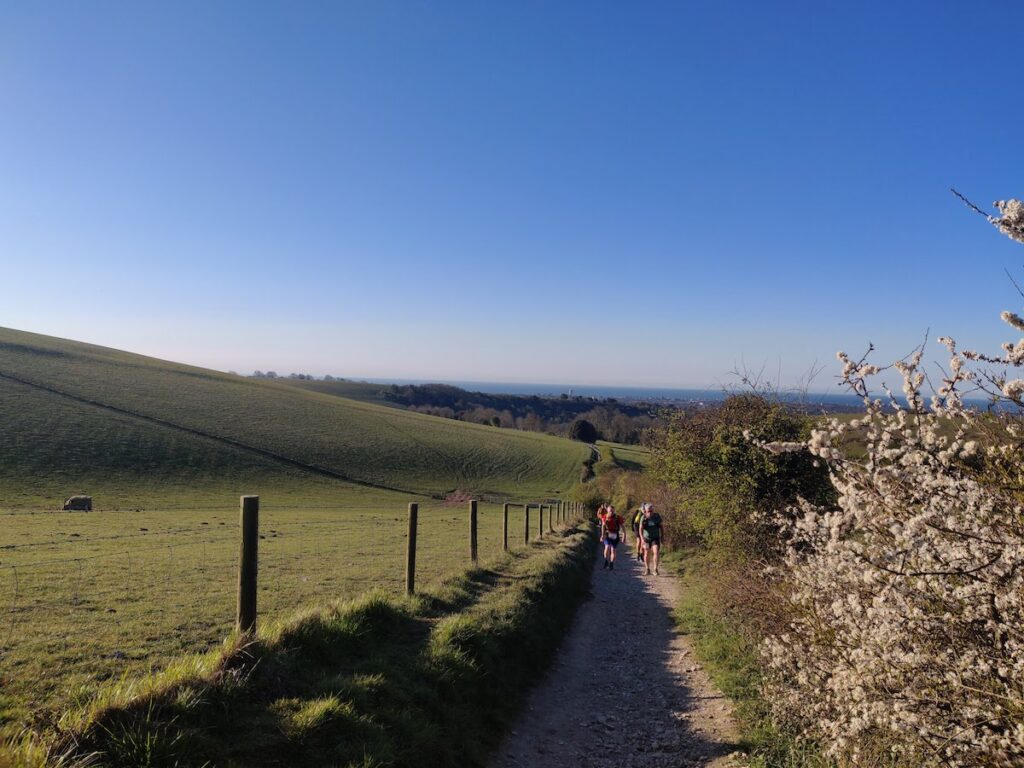
The route, which began with 10km of non-SDW footpaths, soon began to climb up onto the ridge of the Downs. I hung behind a pair of runners – one male and one female – who were taking the climb at what felt like just a bit slower than my kind of pace. On a few occasions, the opportunity to overtake them arose, but I knew to spend at least the first 5km just letting myself loosen up.
At one point, the guy in front, who was quite talkative, stated somewhat brashly that his ego would take a bruising if the woman he was running with beat him. She half-laughed, perhaps partly in astonishment (she was clearly younger and fitter than him), but he soon qualified his statement by explaining that, “Actually, there’s a few women in my running club, and some of them I really struggle to keep up with.”
Needless to say, the woman soon left him in the dust, and I followed her. She offered to let me pass, but I said I was quite alright to hang with her for a bit. I pointed out that the fellow we’d just left must be feeling a bit sheepish. “I have to say, I didn’t expect that this early in the race,” she replied.
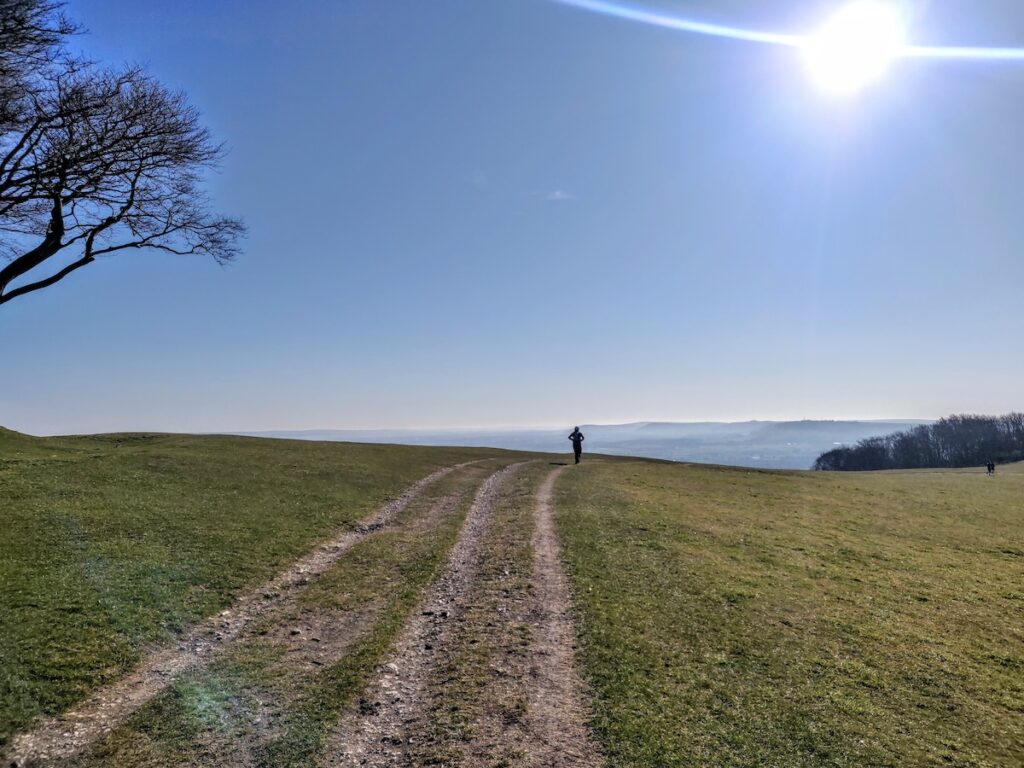
Within half an hour or so of starting the sunlight started warm us up, and I removed my windproof and stuffed it into my pack. Unfortunately, I quickly realised that my bottles – which I had carried in my drop bag to the start – had leaked most of their contents before starting. On the plus side, this meant I had a light pack, but I also only had around 250ml of water or so to see my through the first 18km to the Botolphs aid station. Not ideal, but given that the heat of the day was yet to fully arrive, not the end of the world. I supplemented this lack of water with a SiS gels, which are much less viscous than other brands of gel and do a good job quenching thirst. This did the trick and got me to the first aid station in decent shape, with 18km in my legs and just under two hours on the clock.
I had anticipated a small queue for the first aid station, but luckily this wasn’t the case. Approaching it, I laid out a quick plan based on my goal of ‘in and out, no hanging about’. I decided to fill only the one bottle, knowing that the next aid station was just 8km away. Other than that, I grabbed a single-serving packet of strawberries and a Gu Gel which looked appetising, and was immediately on my way. The volunteers were all very welcoming, and after thanking them as I crossed the main road I began the climb up Truleigh Hill.
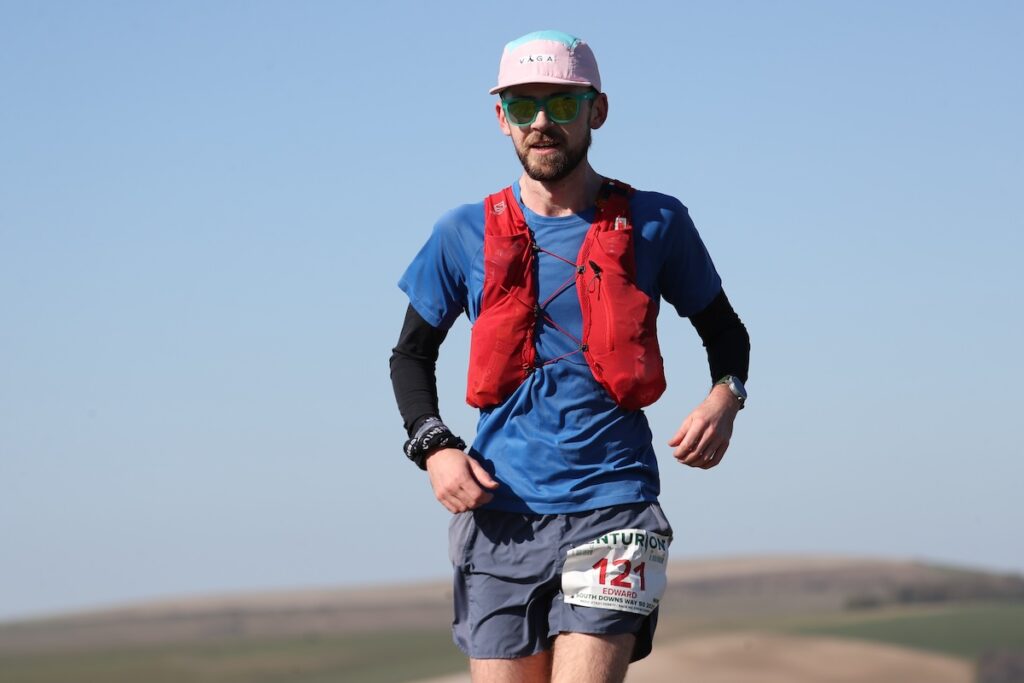
I managed to maintain a good pace on this climb, even gently running some of the shallower gradients. Before I knew it, I was at the Saddlescombe aid station, which slightly caught me off guard as it wasn’t in a valley but atop the hill. I said hello to fellow London-based trail runner Sonny, who was out volunteering. Due to the social distancing necessary to stage the race in COVID times, there was a short queue for the aid station, but really the whole thing added maybe one or two minutes onto my time – a small price to pay for the chance to race again, and actually a good chance to catch my breath and strategise.
Knowing that the next aid station at Housedean Farm was 17km away, I made sure to refill both water bottles at Saddlescombe. I pushed a little bit over the next section, mostly on the downhills. I walked most of the ups, but there was enough flat or moderately graded running that I was able to really pick up the pace a bit. I noticed on the downhills that my feet were sliding around a bit and I was risking a blister. Thankfully, cranking down the laces seemed to do the trick.
We passed through Pyecombe Golf Course, where, almost three years ago, I had surreptitiously set up a wild camp as the sun was setting, the perfect skies rendering any kind of shelter beyond a bivy bag unnecessary. Coming down off Ditchling Beacon, I ran for what felt like an hour with a friendly woman from Tunbridge Wells whose name I unfortunately didn’t catch. Our paces were perfectly matched (as were our blue T-shirts), and I hung behind her as we began the long gradual descent from Ditchling down to Housedean. Briefly, the trail skirts through a patch of ancient woodland, where it climbs a particularly steep, small hill before descending sharply into Housdean. I left behind my Kentish companion on this climb – she started after me, so was actually ahead of me at this point – and bounded into the aid station, Bon Jovi ringing in my ears – woah, we’re halfway there…

I had until this point resisted the temptation to drink Coke (or perhaps it was Pepsi) at any of the aid stations. This was partly because I wanted to rely on less artificial food sources like fruit and crisps, but also because it gave me a bit of motivation to get to the halfway point. Now safely over that line at around 43km, I helped myself to a cup of Coke after refilling my water bottles at Housedean (there was again a small queue, but nothing crazy) and strode out of the aid station and up the hill to cross over the A27.
I was still moving really well at this point, and having reached the halfway point in around 4:25 I began to wonder if a sub-nine hour finish was on the cards. But, in truth, the race had yet to begin, and as I began the long climb up and around the great amphitheatre near Castle Hill, I felt the yawning chasm of the dreaded ‘middle section’ of the race starting to open up before me. Though I was still moving well, it was slowly but surely becoming more of an effort to keep the pace up, and a familiar low-level sense of dread began to buzz in my gut. The pain cave was on its way.
This anxiety was amplified by my surroundings. Despite their majesty, the South Downs have for me always held a certain air of trauma. Around 3000 years ago, these rolling hills would have been covered in dense native forest, the likes of which exists today in Southeast England only in the form of hesitant pockets of woodland squeezed between featureless fields and the back gardens of suburban edgelands. That ancient forest was cleared from the Downs by Neolithic Britons, and to this day it is kept at bay by flocks of grazing sheep, themselves genetic storehouses of thousands of years of human interference.
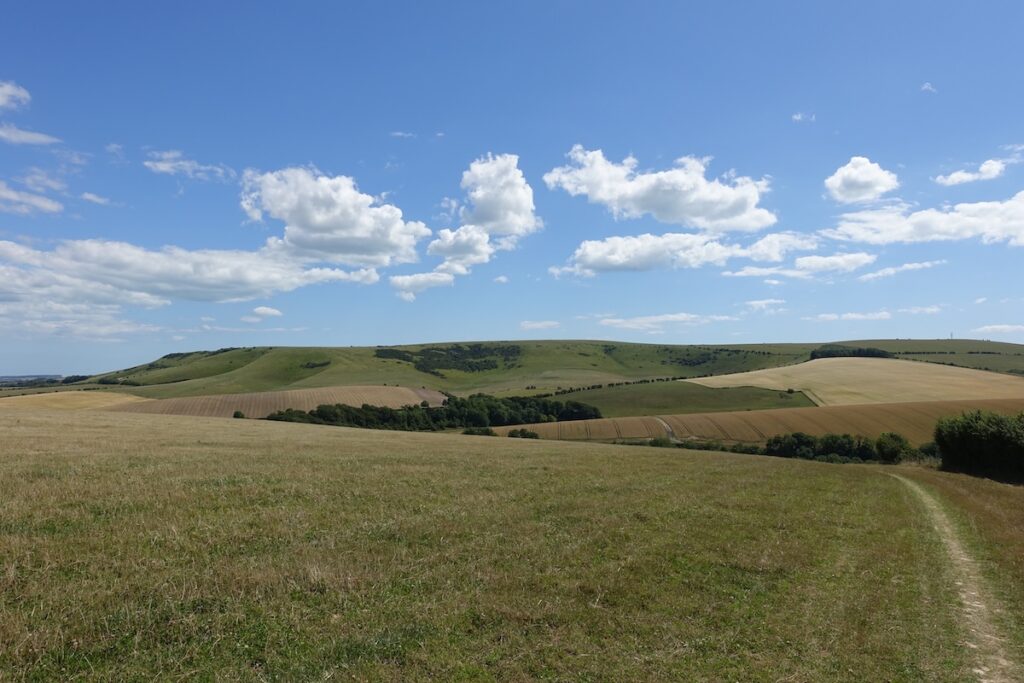
Stunning as the South Downs are in their modern, exposed form, there’s no getting away from the fact that they are a post-human landscape, and this historic reality is reflected in the experience of traversing them. Here, there are none of the subtleties of the forest. One is not watched by timid birds from the canopy above, whilst squirrels flit between the trunks of ancient oaks and earthworms burrow through the mulch. On the Downs, there is only air, grass, and chalk that sometimes breaks through the surface like bone. The open expanses play tricks on your sense of perspective, rendering the landscape in liminal, dreamlike tones. Always, on the Downs, there is a roaring in my ears, not unlike some of Ian William Craig’s more wide-open soundscapes, which are at once indescribably beautiful and yet terrifying, like something ancient and half-forgotten.
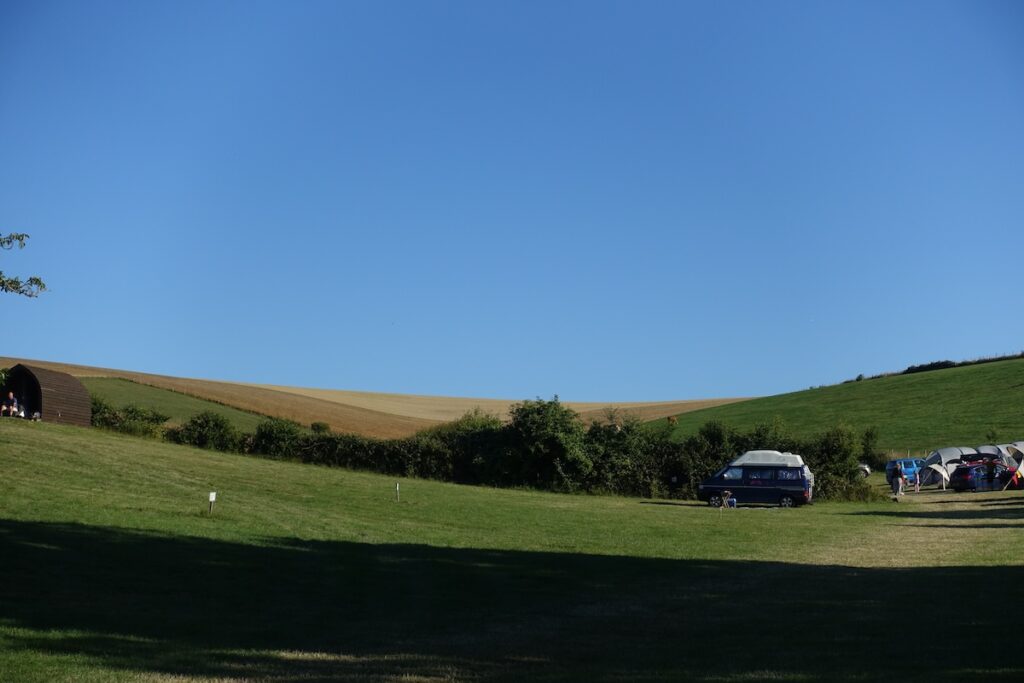
So it was that this feeling of being in the presence of an unwelcoming behemoth grew as the race progressed. The next 20km or so were definitely challenging. The end was not yet worth thinking about, and instead I was reduced to focusing on nothing but my legs moving underneath me. The climb out of Southease aid station was possibly the hardest of the day, psychologically. It is simply very, very long, and not visible in its entirety at any point. Multiple times you are tricked into thinking you have finally crested the hill, only to discover yet another slope rolling up and away from you. The splendid sight of the paragliders atop the hill did cheer me up a little, though – as did the claps and cheers of supporters out meeting their runners at various points on course. Nothing makes you feel more like a superhero than spectators at an ultra wishing you well.
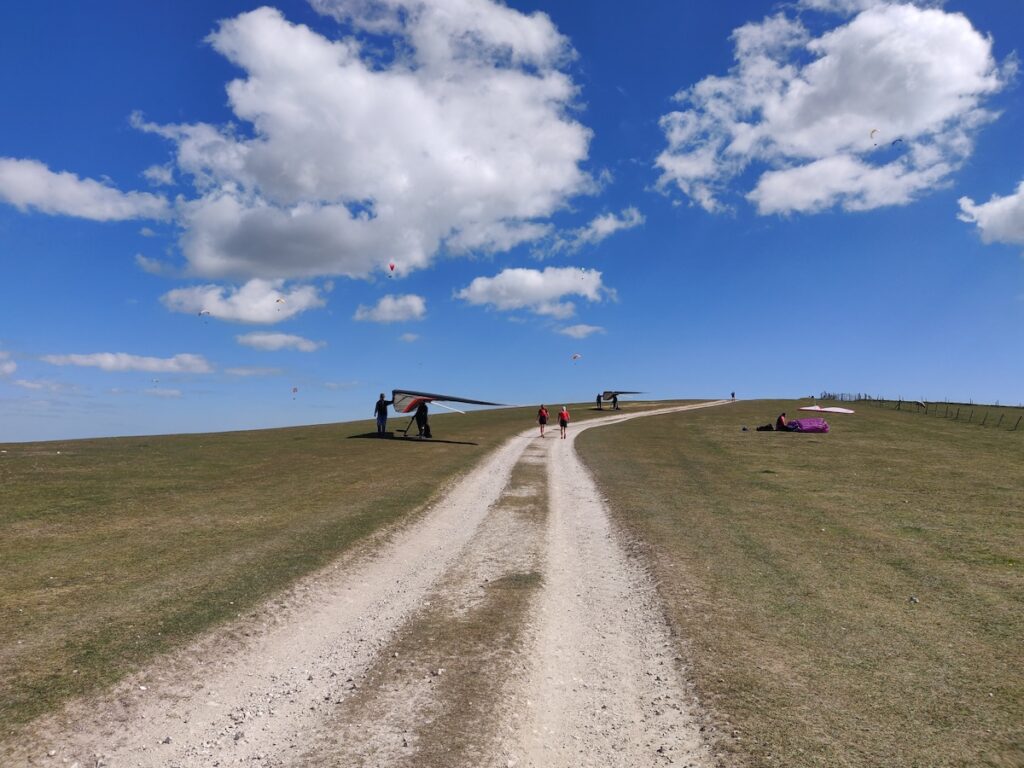
Finally, the descent into Alfriston appeared, and as my watch ticked over the 60km mark, I began to smell the finish. It’s one of the joyful absurdities of ultrarunning that ‘just a half marathon to go’ is a sentiment that makes perfect sense but, to me, 20-odd kilometres is just about the longest distance I can comfortably describe as ‘no big deal’. Of course, 20km is quite a different ask when you’ve already got 60 in your legs. The prospect of a sub-9 hour finish soon slipped away, though I knew that a PB was almost guaranteed so long as I kept moving well.
Although I was feeling pretty rough at this point psychologically, I am, upon reflection, quite pleased with how my body held out for this race. Aside from a minor lower back twinge which I put down to a lack of strength training, I suffered no significant aches or pains beyond the usual fatigue. I was able to run downhills right to the end at a decent pace, although technical terrain (of which there is very little on the South Downs) was definitely more challenging towards the end. All day I was consistently overtaking people, and although there was no way of knowing in what position we stood relative to each other, I felt like I was definitely faring better than 80-90% of the runners I saw in the final third.

At the Alfriston aid station I filled up with more water and my usual cup of Coke for the road. I crossed the famous white bridge and entered unknown terrain for the first time – having only ever taken the coastal route over the Seven Sisters, I knew very little about what to expect from the final 13km or so of the inland route. Fellow Centurions in the Facebook group had warned me that the final three climbs – from Southease to the finish – were the hardest, though, and they were not wrong.
The climb out of Alfriston was, quite frankly, horrendous. It was at first covered by trees, which was a welcome break, and very steep, which was actually a relief as such gradients eliminate the need to ask myself, “Could I run this?” It soon opened up, though, and took a meandering route around the edge of another natural amphitheatre and past the Long Man of Wilmington (not visible from the trail). I did my best to maintain a strong powerhiking pace, and although I was physically moving well, it was very much a case of just getting my head down and waiting for it to be over.
Blessedly, it soon was, and after a quick pitstop at Jevington I headed out onto the final climb feeling a strange mix of euphoria and despair; euphoria that the finish line was within my grasp, but despair that the race had saved its worst climb for last. In truth, the Jevington climb ascends 120m in 1.6km – not as bad as, say, the climb out of Botolphs near the beginning of the race. But, of course, there is a world of difference between the two!
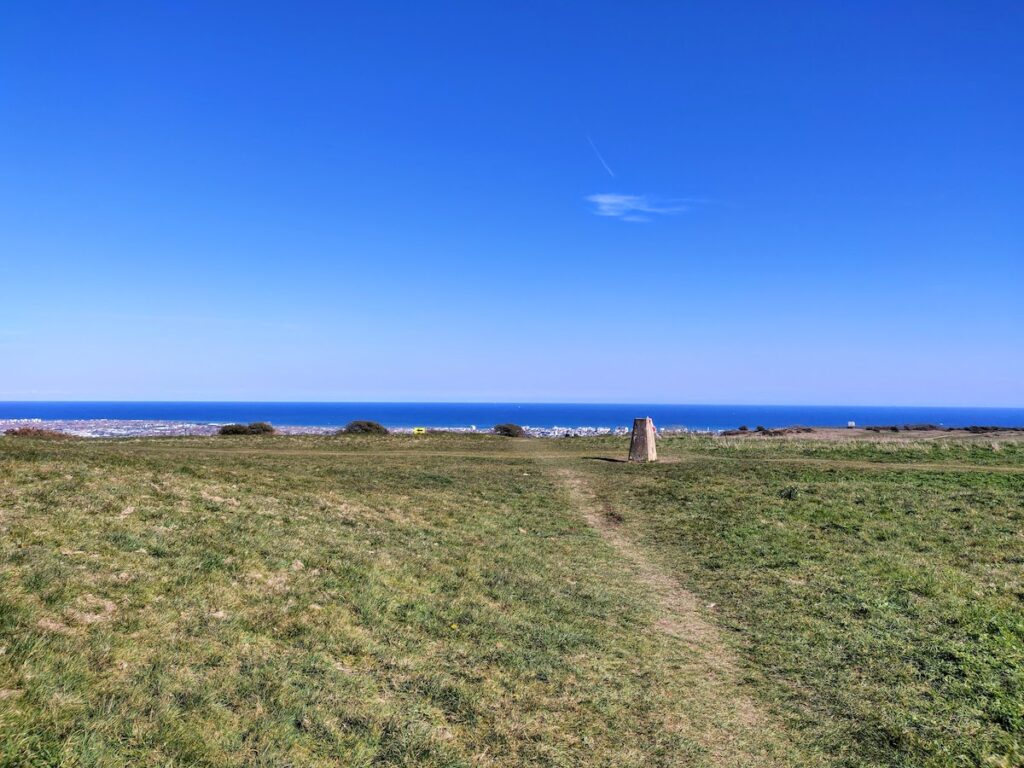
After what felt like an age, I reached what can only be described as the most beautiful trig point I’d ever seen. A friendly volunteer welcomed me and another runner close behind me, and pointed us in the direction of the final descent. With all the climbing now behind me, I tried to let myself go on the narrow gulley, though it was so technical that I had to pick my way down it at times. The runner I was with took the right-hand trail when it split, which I think was more manageable (a note for my future self). A friendly Eastbourne runner on his way up stood aside to let me pass, despite my slow shuffle, and gave me some welcome words of encouragement as I descended.
Reaching the suburbs of Eastbourne, I slowly picked up the pace on the flat road, managing a 6 minute kilometre and then a 5:51. I pushed even more on the cycle track leading up to the athletics track, where dozens of supporters were parked to cheer their runners home. Reaching the track was an absolutely fantastic feeling, and I cruised around it at sub-5 minute pace, grateful for the event to be over, and that all my training had paid off. On the final 200m home stretch, I watched my average pace drop from 7:01/km to a nice round 7 minutes, and I crossed the track in 9:12:24, a good 39 minutes ahead of my previous PB.
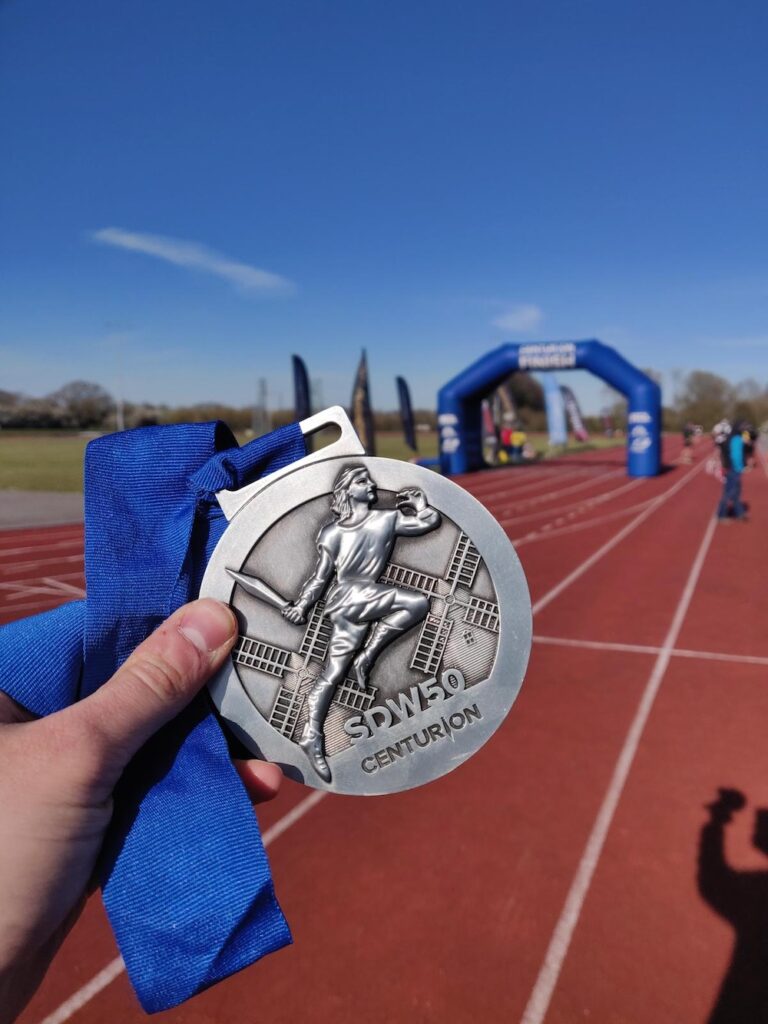
Afterthoughts
All in all, I would call my South Downs Way 50 a very successful race, especially as an official 50-mile debut. I finished in 84th place, 80th male, and 34th in my age category. Through the first aid station, I was in 167th place, meaning I overtook more than 80 people throughout the event. I think this is a good sign that I ran a well-paced event and was able to push throughout.
Ultrarunning is often described in terms of addiction. It’s no secret that the sport carries its fair share of addicts, and it’s not hard to see why. The narrative that underpins all addiction is straightforward: more. I want more. More drink, more drugs, more miles. Simple.
Except, I don’t think it is. In fact, I think ultrarunning’s allure lies in it being the exact opposite of addictive behaviour. When an alcoholic drinks, he feels good. Really good. So he drinks more, to keep on feeling good. Eventually, he will either run out of alcohol or black out. Either way, when he is next sober, he won’t be feeling so good, physically or spiritually, about all that fun drinking.
This is a standard addictive pattern. It feels great, until it doesn’t. Ultrarunning, I would argue, is the mirror image of this process. It feels bad – terrible, at times. You can’t imagine ever wanting to run another step, let alone sign up for another god damn stupid race ever in your life. Ever. But then, eventually, it’s over. And as the hours turn into days and your body recovers, the painful memories callus over…
…and you feel fantastic.
I imagine this is something ultrarunning shares with other sports, particularly those that demand an extreme dedication to a singular athletic dimension like endurance, strength, or speed. I sometimes feel a strange affinity with weightlifters, despite our sports being literally at opposite ends of the spectrum – where ultrarunners eke their energy out over hours, or even days, weightlifters pour as much effort as possible into a couple of explosive seconds. With both sports, the argument holds: an addict pays for their high with agony, an athlete pays for their agony with a high.
There were multiple occasions during the SDW 50 where I seriously thought about dropping out of the 50 mile grand slam. But I knew even as I entertained such fantasies that they were delusional – a result of my egoic mind, caught up in the suffering of the moment, attempting to overwrite the deeper desires of my psyche. Maintaining faith in those deeper structures, rather than the petty comings and goings of the ego, is part of what is so gratifying about ultrarunning. As a reward for the four or five-odd hours of suffering that made up the latter part of this particular race, I enjoyed (and continue to enjoy) a deep sense of gratification at having accomplished my goal.
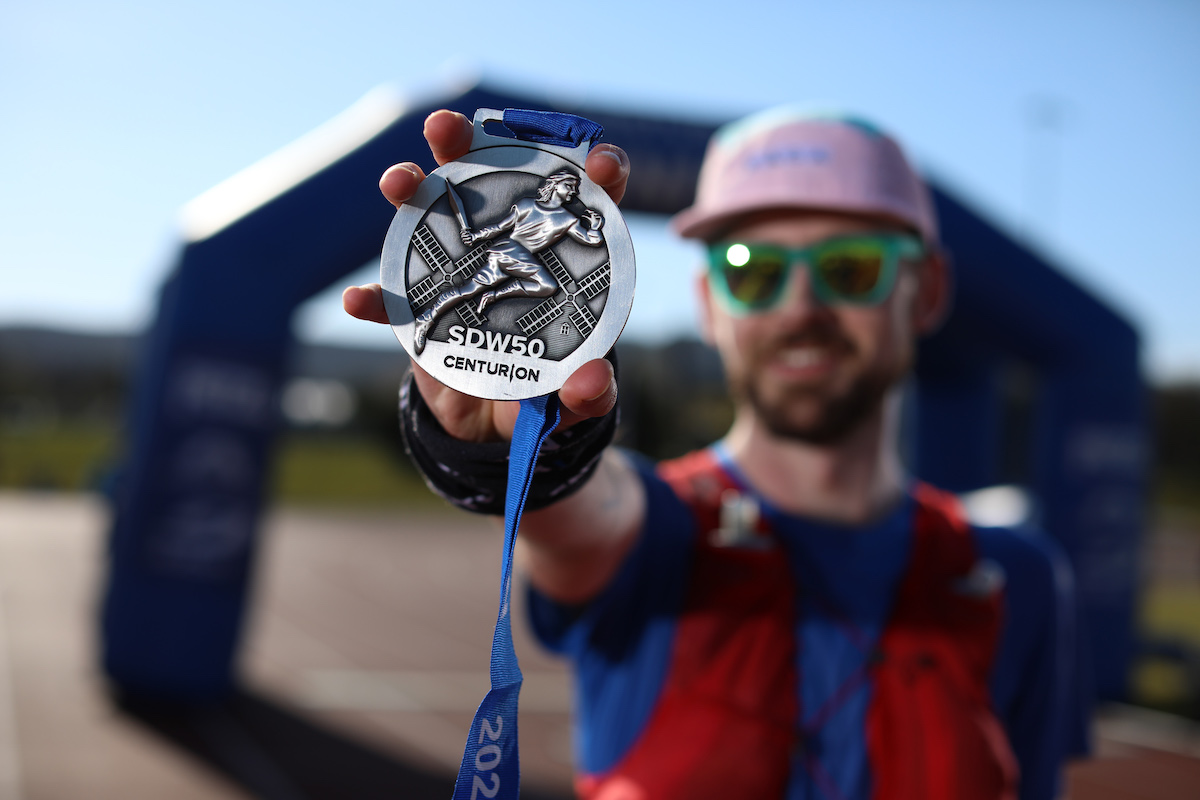
3 comments on "The South Downs Way 50"
Kirstie
April 27, 2021 at 6:27 pm
Ed, I really loved this blog. Really captured what it’s all about. Will see you at the NDW50 for my debut at that distance. Will be some way behind but I will be taking some of your strategies with me.
Ed
May 2, 2021 at 8:34 am
Thanks for the kind words Kirstie! Best of luck at the NDW 50, going to be a great race 🙂
Ruth williams
April 28, 2021 at 3:30 pm
I hope I feel like this when I finish the marathon
Comments are closed.